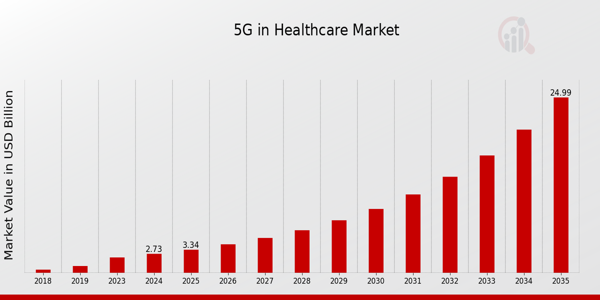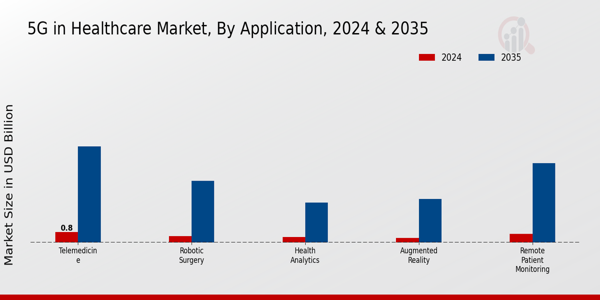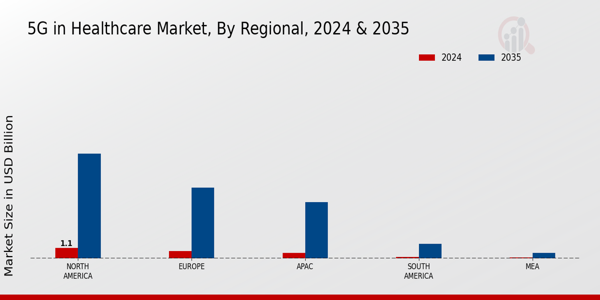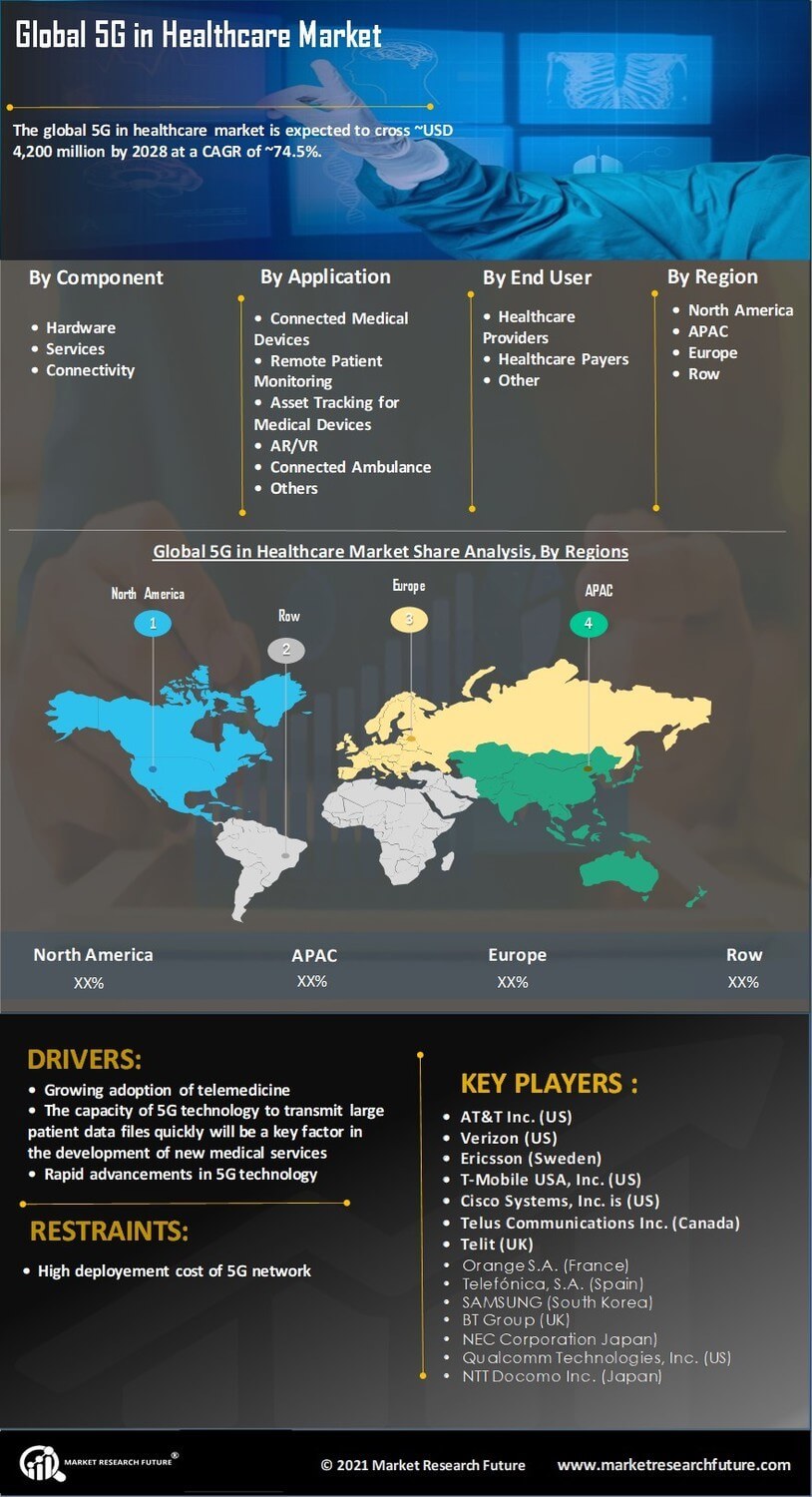5G in Healthcare Market Overview
As per MRFR analysis, the 5G in Healthcare Market Size was estimated at 2.24 (USD Billion) in 2024.The 5G in Healthcare Market Industry is expected to grow from 2.73(USD Billion) in 2025 to 25 (USD Billion) by 2035. The 5G in Healthcare Market CAGR (growth rate) is expected to be around 22.28% during the forecast period (2025 - 2035).
Key 5G in Healthcare Market Trends Highlighted
The Global 5G in Healthcare Market is experiencing significant trends driven by the increasing demand for high-speed connectivity and the need for real-time data transmission in medical settings. Enhanced telemedicine services have emerged as a key market driver, with healthcare providers striving to offer remote consultations and virtual care solutions. The shift towards personalized medicine, supported by advanced analytics and connectivity capabilities afforded by 5G, allows for more tailored treatment plans and better patient outcomes. Additionally, the growing adoption of wearable health devices and remote monitoring systems is propelling the integration of 5G technology, as these devices require robust, low-latency connections to effectively transmit patient data and ensure timely interventions.
Opportunities exist for innovative healthcare solutions that leverage 5G to enhance operational efficiency and reduce costs. Hospitals and healthcare facilities can explore the use of 5G networks to streamline processes such as patient management and data sharing, helping to improve overall service delivery. The potential for real-time remote surgeries or robotic-assisted surgeries offers substantial possibilities for professionals in the healthcare industry, expanding the capabilities of healthcare providers globally. Recent trends indicate that healthcare systems are actively piloting 5G applications, leading to advancements in areas like augmented reality for surgical training and robotics for rehabilitation.
Furthermore, the COVID-19 pandemic has expedited the incorporation of digital health technologies, solidifying the relevance of 5G in promoting patient-centric care. Governments and regulatory bodies are beginning to support the establishment of robust digital health infrastructures that align with 5G technology, fostering growth in both urban and rural healthcare settings worldwide. This collaborative environment positions the Global 5G in Healthcare Market for sustained expansion, addressing the future needs of patients and healthcare providers alike.

Source: Primary Research, Secondary Research, MRFR Database and Analyst Review
5G in Healthcare Market Drivers
Increasing Demand for Telemedicine Services
The rise in telemedicine services is significantly propelling the Global 5G in Healthcare Market Industry. As patients seek remote consultations to avoid hospitals, healthcare providers are adopting advanced technologies that benefit from 5G capabilities such as high-speed data transfer and reduced latency.Major establishments like the Mayo Clinic and Johns Hopkins are leading the way in integrating telemedicine into their service delivery, showcasing that healthcare services can maintain quality and efficiency using 5G technology. This rapid adoption suggests a growing need for reliable and fast connectivity to support virtual care platforms, potentially leading healthcare organizations to invest more towards 5G infrastructure, thus offering a significant growth avenue for Global 5G in Healthcare Market Industry.
Advancements in Remote Patient Monitoring
The adoption of advanced remote patient monitoring devices is a crucial driver for the Global 5G in Healthcare Market Industry. With the emergence of wearables that require constant data exchange, the necessity for enhanced bandwidth and reduced latency supplied by 5G technology has grown. A study published by the Global Health Observatory estimated that the use of remote monitoring devices could reduce hospital readmission rates by over 30%, highlighting the importance of real-time data transmission.Organizations such as Philips and Medtronic are developing sophisticated monitoring systems that utilize 5G, thus boosting patient outcomes and reducing healthcare costs. As these technologies gain traction globally, the demand for seamless connectivity will further bolster the Global 5G in Healthcare Market Industry.
Increased Investment in Healthcare Infrastructure
Significant investment in healthcare infrastructures, driven by government initiatives and private sectors, is propelling the Global 5G in Healthcare Market Industry forward. For instance, the European Union has committed around 9 billion Euros to digital health initiatives, promoting the integration of high-speed internet connectivity in healthcare. This investment is pivotal, as enhanced infrastructure leads to improved data management systems, which in turn facilitates the efficient application of 5G technology in healthcare communications.Institutions like the Cleveland Clinic are also actively investing in 5G integration into their services, demonstrating the forward momentum of industry adoption worldwide. As a result, increased investments will catalyze advancements in healthcare services, consequently driving growth in the Global 5G in Healthcare Market Industry.
5G in Healthcare Market Segment Insights
5G in Healthcare Market Application Insights
The Global 5G in Healthcare Market reflects a significant shift in how healthcare services are delivered through advanced technologies, especially within the Application segment. The overall market is projected to reach a valuation of 2.73 USD Billion in 2024, with substantial growth anticipated as the market steadily advances towards a valuation of 25.0 USD Billion by 2035. The contributions of different applications within this market reveal noteworthy insights into their respective impacts and potential. Telemedicine, valued at 0.8 USD Billion in 2024 and expected to reach 7.5 USD Billion by 2035, is a vital driver of this market, enabling remote consultations and improving access to healthcare. Remote Patient Monitoring follows closely with a valuation of 0.65 USD Billion in 2024 and anticipated growth to 6.2 USD Billion in 2035, showcasing its importance in chronic disease management and personalized care through real-time monitoring technologies.
Robotic Surgery, valued at 0.5 USD Billion in 2024 with a projection of 4.8 USD Billion by 2035, is gaining traction as it enhances surgical precision and minimizes recovery time for patients, thus transforming surgical practices globally. Augmented Reality, valued at 0.36 USD Billion in 2024, is set to expand to 3.4 USD Billion by 2035, proving significant in training and simulation environments, allowing healthcare professionals to practice procedures in a risk-free setting. Health Analytics, with an initial valuation of 0.42 USD Billion in 2024 and a projected value of 3.1 USD Billion in 2035, is increasingly recognized for its capacity to harness data insights to improve patient outcomes and streamline operations within healthcare systems.
Collectively, these segments showcase a robust demand for enhanced connectivity and data management capabilities that 5G technology delivers. The integration of these innovative applications paves the way for improved healthcare efficiency, better patient engagement, and overall enhanced health management practices. As the healthcare industry navigates through various challenges such as accessibility, patient care optimization, and operational costs, the role of high-speed networks like 5G emerges as a game-changer, making these applications critical to achieving more resilient healthcare systems globally. The continuous developments and investment in these Application segments highlight the vast opportunities that exist within the Global 5G in Healthcare Market.

Source: Primary Research, Secondary Research, MRFR Database and Analyst Review
5G in Healthcare Market Use Insights
The Global 5G in Healthcare Market showcases significant growth, especially across various end-use applicationsHospitals and clinics are anticipated to be the primary sectors utilizing 5G technology due to the need for quick data transfer and real-time communication among healthcare professionals. The increased adoption of telemedicine and remote monitoring in homecare services indicates a shift towards patient-centric approaches driven by 5G’s high-speed connectivity.Emergency Medical Services (EMS) benefit from enhanced communication systems and real-time data exchange during critical situations, improving response times and care delivery.
Meanwhile, the pharmaceuticals sector is poised to leverage 5G for improved supply chain management and clinical trials, enhancing efficiency and accuracy. The overall market growth is propelled by technological advancements, the increasing demand for telehealth solutions, and the rising prevalence of chronic diseases globally. However, challenges such as infrastructure investment and regulatory frameworks may hinder the pace of adoption.With these dynamics, the Global 5G in Healthcare Market segmentation indicates a promising future across diverse applications, demonstrating potential for growth and innovation.
5G in Healthcare Market Connectivity Type Insights
The Global 5G in Healthcare Market is poised for significant growth driven by its Connectivity Type, which encompasses Enhanced Mobile Broadband, Ultra-Reliable Low Latency Communications, and Massive Machine Type Communications. Enhanced Mobile Broadband plays a pivotal role in enabling high-definition video consultations and remote monitoring, thus enhancing patient experiences.Ultra-Reliable Low Latency Communications is crucial for applications like tele-surgery and remote operations, which require instantaneous response times for critical healthcare decisions.
Meanwhile, Massive Machine Type Communications enables connectivity for a multitude of devices, facilitating the seamless integration of medical devices and Internet of Things (IoT) solutions in healthcare environments. This growing emphasis on connectivity solutions highlights a shift towards innovative healthcare delivery models, where real-time data transmission is essential for improved patient outcomes.The insights into Global 5G in Healthcare Market data reveal that advancements in these connectivity types are driven by needs such as improved access to healthcare services, operational efficiency for hospitals, and enhanced patient care management. With the Global 5G in Healthcare Market statistics indicating robust growth potential, understanding these connectivity types is essential for stakeholders aiming to capitalize on emerging opportunities in the healthcare landscape.
5G in Healthcare Market Component Insights
The Global 5G in Healthcare Market is poised for substantial growth, particularly in the Component segment, which comprises Hardware, Software, and Services. As 5G networks enable rapid data transmission and improved connectivity, the demand for hardware components, such as advanced medical devices and infrastructure, is significant. Software solutions are also critical, facilitating telemedicine, remote monitoring, and data management, thus driving efficiency in healthcare delivery.The services componentcompassing installation, maintenance, and supportplays a vital role as healthcare providers navigate this technological transition. The collective impact of these components underscores their importance in transforming patient care, enhancing operational efficiency, and improving health outcomes globally. This segmentation of the Global 5G in Healthcare Market illustrates the diverse nature of technology integration into healthcare systems, supporting various use cases that leverage the benefits of high-speed connectivity.
5G in Healthcare Market Regional Insights
The Global 5G in Healthcare Market is poised for significant growth by 2035, with the overall market expected to reach a valuation of 25.0 USD Billion. North America is emerging as a major player, with a valuation of 1.1 USD Billion in 2024 and expected to surge to 10.8 USD Billion by 2035, primarily driven by advanced healthcare infrastructure and rapid technological adoption. Europe follows, valued at 0.75 USD Billion in 2024 and projected to grow to 7.3 USD Billion, reflecting significant investments in telemedicine and digital health solutions.The Asia-Pacific (APAC) region, with a value of 0.6 USD Billion in 2024 and expected to reach 5.8 USD Billion, is witnessing growing demand due to rising healthcare needs and government initiatives promoting digital health transformations.
South America and the Middle East and Africa (MEA) display smaller market sizes, with values of 0.18 USD Billion and 0.1 USD Billion respectively in 2024. However, these regions represent emerging markets with considerable potential for growth driven by increasing mobile connectivity and healthcare digitization efforts.The diverse landscape across these regions showcases a varied pace of adoption and sets unique opportunities and challenges shaped by local regulatory frameworks, technology readiness, and investments in healthcare infrastructure. Overall, the Global 5G in Healthcare Market exhibits a robust trajectory as healthcare providers worldwide seek to leverage advanced connectivity for enhanced patient care, operational efficiency and continuous monitoring solutions.

Source: Primary Research, Secondary Research, MRFR Database and Analyst Review
5G in Healthcare Market Key Players and Competitive Insights:
The Global 5G in Healthcare Market is witnessing significant growth driven by advancements in technology and increasing demand for efficient healthcare services. The integration of 5G technology in healthcare is enhancing communication, data transfer, and telemedicine services, thus allowing for real-time remote monitoring and significantly improving patient outcomes. As the market evolves, various companies are positioning themselves through strategic initiatives, product innovations, and collaborations to capture market share and meet the diverse needs of healthcare providers and patients. The competitive landscape is characterized by the entry of both established players and emerging startups, all vying to leverage the opportunities presented by 5G in healthcare.IBM has a solid presence in the Global 5G in Healthcare Market, leveraging its strengths in cloud computing, data analytics, and artificial intelligence.
The company is focused on creating solutions that enhance patient care through better data integration and predictive analytics. IBM's capabilities in managing large datasets and providing insights through its AI systems give it a competitive edge. In addition, its partnerships with various healthcare providers ensure that it stays at the forefront of digital transformation in the healthcare sector, further enabling seamless connectivity and interactivity between healthcare devices and services. The company's dedication to innovation and improving healthcare delivery through technology continues to strengthen its position in this rapidly evolving market.
Siemens Healthineers has established a notable presence in the Global 5G Healthcare Market by offering a range of advanced medical imaging and diagnostic solutions that are enhanced by 5G technology. With key products focused on imaging technology and laboratory diagnostics, Siemens Healthineers is well-positioned to support healthcare providers in delivering timely and accurate patient care. The ability to transmit high-resolution images swiftly and securely through 5G networks stands as a significant advantage for the company, allowing for improved collaboration between healthcare professionals. Siemens Healthineers has also engaged in strategic mergers and acquisitions to bolster its technological capabilities and market reach, further enhancing its service offerings in the global healthcare landscape. This commitment to innovation and comprehensive solutions solidifies its competitive edge in harnessing 5G capabilities to transform healthcare delivery.
Key Companies in the 5G Healthcare Market Include:
- IBM
- Siemens Healthineers
- ZTE
- AT and T
- Dell Technologies
- Huawei
- Verizon Communications
- Intel
- Microsoft
- Cisco Systems
- Qualcomm
- Samsung Electronics
- Broadcom
- Nokia
- Ericsson
5G in Healthcare Market Industry Developments
The Global 5G in Healthcare Market has seen significant developments recently, fueled by advancements in wireless technology and the increasing demand for telehealth services. Major companies such as IBM and Verizon Communications are actively exploring innovative solutions to enhance patient care, leveraging 5G for remote monitoring and real-time data sharing. In September 2023, Nokia announced a partnership with multiple healthcare providers to deploy 5G technology for improving patient outcomes and operational efficiency. Meanwhile, in October 2023, AT and T collaborated with Samsung Electronics to advance connectivity solutions specifically tailored for healthcare facilities.
Notably, Cisco Systems reported strategic growth, emphasizing 5G integration in their healthcare-related products. Merger and acquisition activities have also been prominent; for instance, in August 2023, Dell Technologies acquired a startup specializing in 5G-enabled health solutions, further strengthening its portfolio in the healthcare sector. The rise in investment in 5G infrastructure globally is projected to drive market valuation, enhancing the capability of healthcare systems to respond to urgent care needs. In recent years, significant events like the rollout of 5G networks worldwide have laid a foundation for transformative healthcare applications, reshaping service delivery and patient engagement.
5G in Healthcare Market Segmentation Insights
5G in Healthcare Market Application Outlook
- Telemedicine
- Remote Patient Monitoring
- Robotic Surgery
- Augmented Reality
- Health Analytics
5G in Healthcare Market Use Outlook
- Hospitals
- Clinics
- Homecare
- Emergency Medical Services
- Pharmaceuticals
5G in Healthcare Market Connectivity Type Outlook
- Enhanced Mobile Broadband
- Ultra-Reliable Low Latency Communications
- Massive Machine Type Communications
5G in Healthcare Market Component Outlook
- Hardware
- Software
- Services
5G in Healthcare Market Regional Outlook
- North America
- Europe
- South America
- Asia Pacific
- Middle East and Africa
| Report Attribute/Metric Source: |
Details |
| MARKET SIZE 2023 |
2.24(USD Billion) |
| MARKET SIZE 2024 |
2.73(USD Billion) |
| MARKET SIZE 2035 |
25.0(USD Billion) |
| COMPOUND ANNUAL GROWTH RATE (CAGR) |
22.28% (2025 - 2035) |
| REPORT COVERAGE |
Revenue Forecast, Competitive Landscape, Growth Factors, and Trends |
| BASE YEAR |
2024 |
| MARKET FORECAST PERIOD |
2025 - 2035 |
| HISTORICAL DATA |
2019 - 2024 |
| MARKET FORECAST UNITS |
USD Billion |
| KEY COMPANIES PROFILED |
IBM, Siemens Healthineers, ZTE, AT and T, Dell Technologies, Huawei, Verizon Communications, Intel, Microsoft, Cisco Systems, Qualcomm, Samsung Electronics, Broadcom, Nokia, Ericsson |
| SEGMENTS COVERED |
Application, End Use, Connectivity Type, Component, Regional |
| KEY MARKET OPPORTUNITIES |
Remote patient monitoring solutions, Enhanced telemedicine capabilities, Real-time data analytics integration, Smart medical devices deployment, Improved emergency response systems |
| KEY MARKET DYNAMICS |
Enhanced patient monitoring, Increased telemedicine adoption, Improved data transfer speeds, Cost reduction in operations, Real-time remote consultations |
| COUNTRIES COVERED |
North America, Europe, APAC, South America, MEA |
5G in Healthcare Market Highlights:
Frequently Asked Questions (FAQ) :
The Global 5G in Healthcare Market is expected to be valued at 2.73 USD Billion in 2024.
By 2035, the Global 5G in Healthcare Market is anticipated to reach 25.0 USD Billion.
The market is expected to grow at a CAGR of 22.28% from 2025 to 2035.
North America is projected to have the largest market share valued at 10.8 USD Billion by 2035.
Telemedicine is valued at 0.8 USD Billion in 2024 and expected to reach 7.5 USD Billion by 2035.
Remote Patient Monitoring is anticipated to grow significantly as part of the overall market growth from 2025 to 2035.
Major players include IBM, Siemens Healthineers, ZTE, AT and T, Dell Technologies, Huawei, Verizon Communications, and others.
The Augmented Reality segment is expected to grow to 3.4 USD Billion by 2035.
Europe's market size is projected to reach 7.3 USD Billion by 2035.
The market offers opportunities in applications such as Telemedicine, Remote Patient Monitoring, and emerging technologies.

















